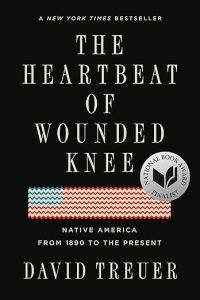 Summary: A reframing of Native American History and reminding the world that Native American history did not end in 1890.
Summary: A reframing of Native American History and reminding the world that Native American history did not end in 1890.
I have intentionally focused my reading on Black American history, but I know that narrow focus limits my understanding of racial history in the US. The story of slavery and segregation of Black Americans is essential, but not the whole story. I have minimal background in Native American history. There were some good sections in Color of Christ, and Richard Twiss’ book Rescuing the Gospel from the Cowboys helps frame issues within Native American Christianity. And Kaitlin Curtice’s memoir Native is well worth reading. But The Heartbeat of Wounded Knee was the first attempt I have made at understanding a larger history.
David Truer is an English professor and fiction writer with a background in Anthropology, not a historian. And the framing of the book is a mix of personal stories to give context to history. Those personal stories of both David Truer and his family, as well as many others from various tribes (and a few from people outside of tribes), give the reader insight into the history and contemporary issues. Of course, no single book can do everything, but from my non-expert position, the breadth of issues and history in a single book is impressive.
There is insight into how US policy has created many of the problems (similar to the framing of Color of Law with housing segregation). Native American tribal government and authority structures are diverse. Still, Truer looks at both the successes and problems of how different groups have structured and how US policy has helped and interfered.
The more recent problems of how DNA has impacted Native American identity is not wholly a new problem, and the history of the Red Power movement and how identity has been constructed and how it may go forward raises some issues that get very complicated quickly.
Truer has a perspective. He is not writing detached, analytical history; he is writing from the perspective of an activist. But he is also clear-eyed and knows that simple framing tools have to be complicated to move forward.
I don’t want to assume that a single book and perspective is all I need. But I think this was helpful as an introduction, and I know I need to keep reading to become open to more blind spots and my lack of understanding of important history.
The Heartbeat of Wounded Knee: Native America from 1890 to the Present by David Treuer Purchase Links: Paperback, Kindle Edition, Audible.com Audiobook